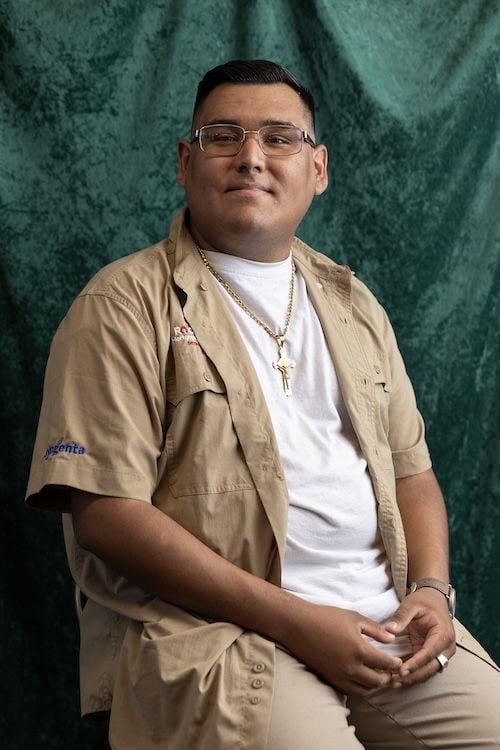Students learn to assess unsafe situations
For years, students in Detroit have had to deal with dangerous commutes to school.
Calvin Colbert, executive director of Detroit Impact, started a Safe Routes to School program in 1995 in which community members monitored kids on their way to and from school. The program, which succeeded in reducing violence, became a model for a similar federal program. But its funding eventually dried up, Colbert said.
“Everybody felt like, ‘well, it’s over,’” he said. “No, the intensity of it may be over, but the existence of violence is still there.”
Colbert said sexual predators pose a threat to students trying to get to school.
“What they do in the early mornings — they scour the bus stops. They identify students who catch the bus. They follow them. They become aware of them,” he said.
Although she could walk to the School at Marygrove, Malaya Ramsey gets a ride from her mother to avoid unwanted attention from men.
“I’m a 15-year-old with a more mature body. So when I go into the outside world, it be like men trying to talk to me and stuff like that,” she said.
Some students carry pepper spray and personal alarms to protect themselves on the bus or walk to school. They make a point not to talk to strangers on public transportation.
“There’s a lot of things happening right now in the world. … People go missing, or somebody can just do something to you at any point if you’re alone,” said Dulce Bravo, 18, who graduated from Western International High School this spring. She carries pepper spray and a personal safety alarm.
“I didn’t feel safe anywhere, or I would always have to keep an eye out,” she said.
Having to be so aware of her surroundings used to weigh on her. But, she said, it doesn’t bother her as much anymore. “As time is going on, I think I’m just starting to accept the fact that things do happen.”
School security measures don’t make all students feel safe
Schools’ security practices vary widely. Some have metal detectors, security guards, and locked doors, but they may not make students feel safer.
Some students said their peers, or even strangers, can get around the metal detector — their security guard isn’t adequately equipped or trained to protect them.
At one school without metal detectors, students reported that teens from a rival school have come in and started fights.
Other students were concerned that their schools’ active shooter drills or fire drills haven’t gone smoothly — and some students don’t take the drills seriously.
When fights and conflicts break out, multiple youth said they’d like to see teachers and administrators get more involved in resolving the problems. Sitting down with the students involved helps sometimes, but “some are more mature than others,” said Ja’Nya Street, 16, a student at the School at Marygrove. Sometimes, the bullying doesn’t stop.
Teachers “tell us to ignore it, ignore it, ignore it until somebody — sometimes people just reach their breaking point,” Street said. “Check up on the incident that happened … don’t just tell them to ignore it and just act like it’s nothing anymore.”
Tiarra Hall, 18, who graduated from WAY Academy West Campus this spring, is a safety ambassador with Detroit Impact. She said fights are the most common safety problem that comes up in her work with the organization.
Detroit Impact helps youth “stay calm in a situation that might disrupt their future,” Hall said. “We’re trying to help them with resolving their issues without beating each other up, and giving them ways to resolve their anger without hurting themselves or people around them.”
When conflicts arise, “they just go to whatever seems the most convenient, and in those cases, it’s physical violence,” she said.
Situations that make youth feel unsafe can cause lasting trauma.
Responses to trauma can be cognitive, psychological, or behavioral — and “our emotional responses can wax and wane,” Carlson, the MSU professor, said. “When we get support, we can have improvement. But it doesn’t mean that we don’t have something arise in our life two months later that brings us right back to that traumatic experience.”
And if someone keeps experiencing the stressor, their responses to it can accumulate, so “it doesn’t make it easier the next time, it actually makes it worse,” Carlson said.

Alexis Escoto, 23. (Photo by Elaine Cromie / Chalkbeat)
For that reason, continuous monitoring of youth who need support should become a natural part of procedural safety processes, he said.
When home isn’t safe
As a child, Alexis Escoto, 23, a member of the Detroit Board of Police Commissioners Youth Advisory Panel, dealt with violence at home because of a family member’s drug problem. And one of his cousins was killed in a drive-by shooting.
Escoto said those traumatic experiences caused him to withdraw. He started skipping school and acting out enough that his teachers would kick him out of class.
“I didn’t want to talk to no one,” he said. “I was paranoid. If I talked to someone, I’m afraid they’d hurt me somehow, or I’d hurt them if they pushed my buttons.”
Children and teenagers who live in unstable home conditions or experience homelessness face extra layers of safety concerns.
Some may live in unsafe situations, such as in homes without running water or heat, said Courtney Smith, CEO of Detroit Phoenix Center, which provides housing and mental health resources and other assistance.
Two children who died in February while living in a van drew widespread attention to the dangers for children living unhoused.
Some families also don’t feel comfortable calling the police for a variety of reasons.
With the Trump administration’s widespread efforts to detain and deport undocumented immigrants, students are concerned about ICE agents coming into schools and communities and taking people away. Escoto said that in his majority-Hispanic community, some people avoid the police because they think they are working with ICE.
When police are around, some youth say they feel more policed than protected, but others want police to be more present in their neighborhoods.
Relationships are key
Even in seemingly safe home situations, youth may feel unsupported.

Camille Hollenquest, 25. (Photo by Elaine Cromie / Chalkbeat)
Many children and teenagers don’t have strong relationships with their parents or guardians, said Camille Hollenquest, 24, executive director of the youth-led organization Detroit Heals Detroit. In those situations, the children “can’t come to you about the things that they’re going through,” they said.
“If you’re not actually curious about what their experiences are, other than just, like, how your day is … actually being invested into who they are as people,” that can cause safety issues, they said.
Many organizations around Detroit have built safe spaces for youth, where they can be who they are and get the support they need. Some of the services they provide respond directly to safety concerns. Others have different functions but also give youth access to trusted adults and peers they can connect with.
Darrell Hall, youth director at Cody Rouge Community Action Alliance, said relationship building is key. “You don’t know anything about what safety issues are present if you don’t know the youth,” he said. “How do you build relationships so youth can say, ‘I’m unsafe at home, or when I’m walking down the street by these abandoned houses,’ or whatever it may be?”
Several of the youth included here go or have gone to these organizations for support, but they also give back themselves, to create safe spaces for others.
One way Escoto moved forward from trauma was by leaning into the community advocacy work he’s been doing since high school. Through various organizations, he has worked “to help the community to be more engaged, get the resources they need, and live in a safe, friendly environment,” he said. “I love seeing the younger kids now having a space in the community center to play soccer or make art or do whatever they want in a safe space.”
Sirrita Darby, co-founder of Detroit Heals Detroit, turned over her executive director role to Hollenquest, so the organization is fully youth led. Hollenquest said they appreciate the opportunity “to be able to show up as a young person in these spaces that aren’t traditionally familiar with catering to the voices and the wants and needs of youth.”
“Sometimes you just need to be in a space with other youth to where it’s like, I understand and I hear you, I feel you, as well as making sure that the youth who are in that space — they have the tools to further navigate situations when another young person is coming to them with the heaviness of their experiences,” Hollenquest said. “Until we have that, I don’t know if youth will be able to actually feel safe.
Youth are coming up with solutions to the safety challenges they’ve faced, Smith said. “They’re building food pantries inside of schools, they’re advocating for policy changes. They’re talking with their state legislators,” and in addressing safety issues, “we need to center solutions that are rooted in youth voice and youth power,” she said.







